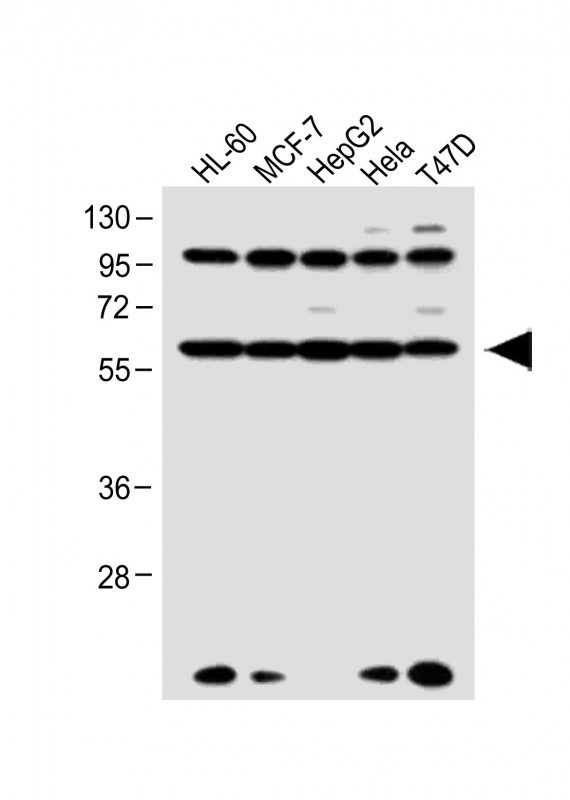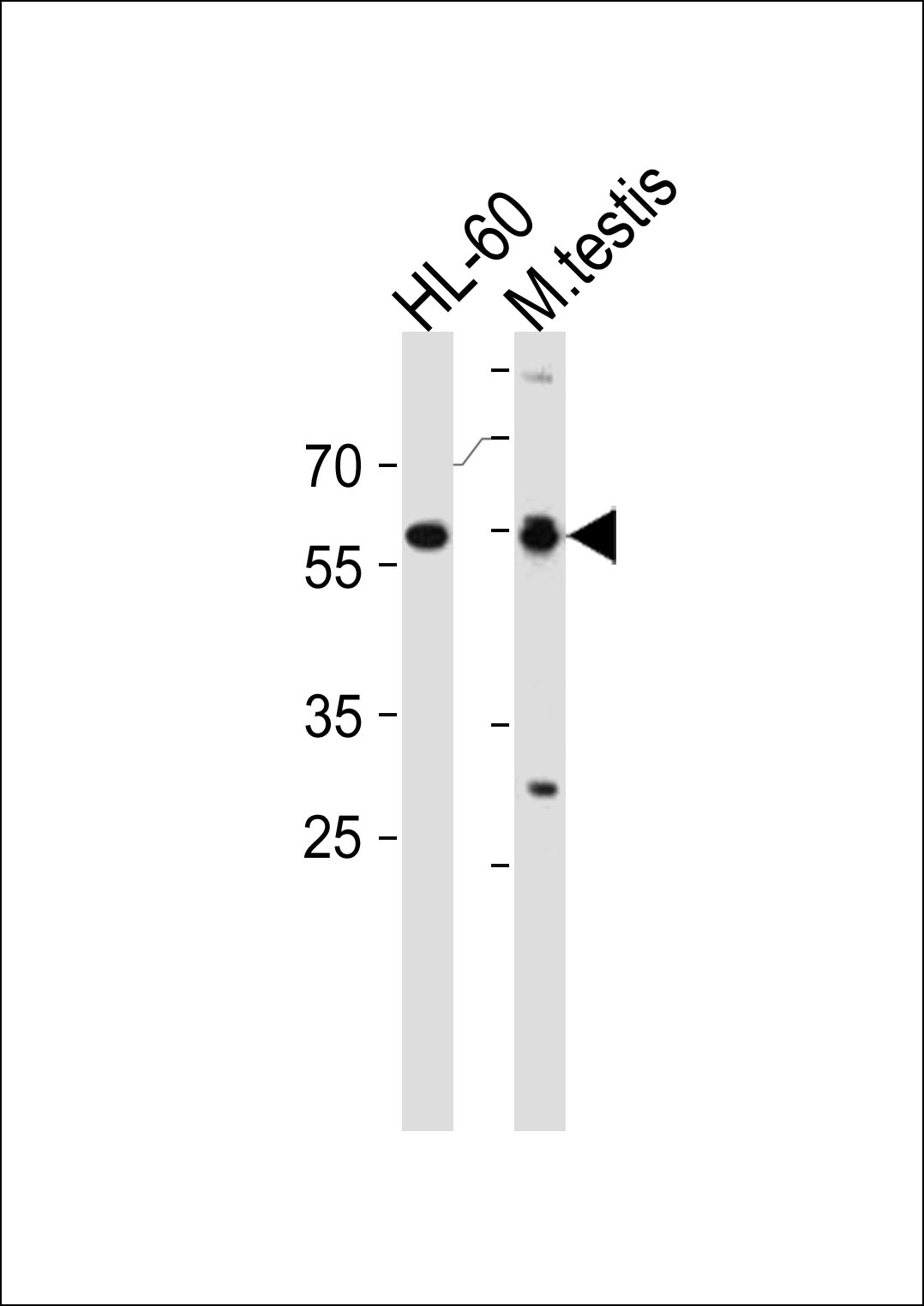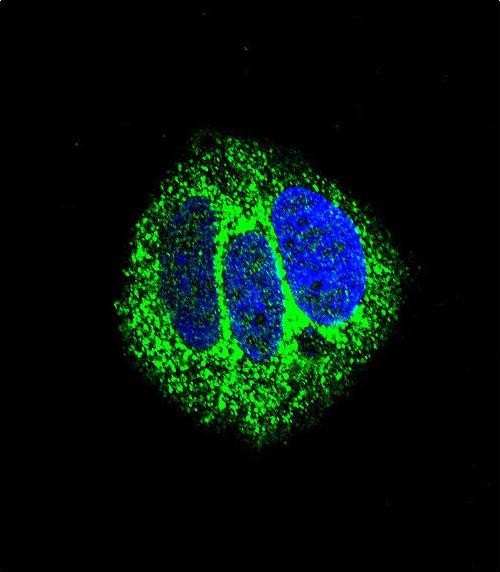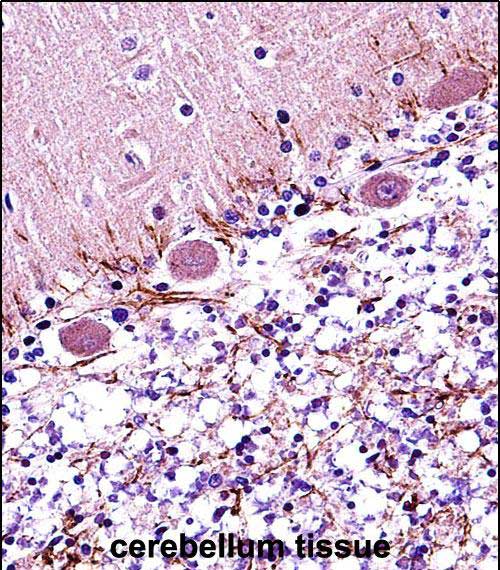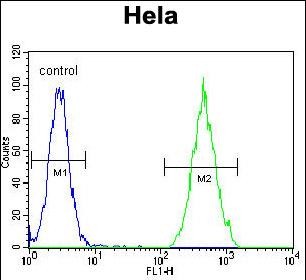RARA Antibody (C-term)
Affinity Purified Rabbit Polyclonal Antibody (Pab)
- 产品详情
- 文献引用 : 1
- 实验流程
- 背景知识
Application
| IF, IHC-P, FC, WB, E |
|---|---|
| Primary Accession | P10276 |
| Other Accession | NP_000955.1 |
| Reactivity | Human, Mouse |
| Host | Rabbit |
| Clonality | Polyclonal |
| Isotype | Rabbit IgG |
| Calculated MW | 50771 Da |
| Antigen Region | 322-349 aa |
| Gene ID | 5914 |
|---|---|
| Other Names | Retinoic acid receptor alpha, RAR-alpha, Nuclear receptor subfamily 1 group B member 1, RARA, NR1B1 |
| Target/Specificity | This RARA antibody is generated from rabbits immunized with a KLH conjugated synthetic peptide between 322-349 amino acids from the C-terminal region of human RARA. |
| Dilution | IF~~1:10~50 IHC-P~~1:100~500 FC~~1:10~50 WB~~1:1000 E~~Use at an assay dependent concentration. |
| Format | Purified polyclonal antibody supplied in PBS with 0.09% (W/V) sodium azide. This antibody is purified through a protein A column, followed by peptide affinity purification. |
| Storage | Maintain refrigerated at 2-8°C for up to 2 weeks. For long term storage store at -20°C in small aliquots to prevent freeze-thaw cycles. |
| Precautions | RARA Antibody (C-term) is for research use only and not for use in diagnostic or therapeutic procedures. |
| Name | RARA |
|---|---|
| Synonyms | NR1B1 |
| Function | Receptor for retinoic acid (PubMed:16417524, PubMed:19850744, PubMed:20215566, PubMed:21152046, PubMed:37478846). Retinoic acid receptors bind as heterodimers to their target response elements in response to their ligands, all-trans or 9-cis retinoic acid, and regulate gene expression in various biological processes (PubMed:21152046, PubMed:28167758, PubMed:37478846). The RXR/RAR heterodimers bind to the retinoic acid response elements (RARE) composed of tandem 5'-AGGTCA-3' sites known as DR1-DR5 (PubMed:19398580, PubMed:28167758). In the absence of ligand, the RXR- RAR heterodimers associate with a multiprotein complex containing transcription corepressors that induce histone deacetylation, chromatin condensation and transcriptional suppression (PubMed:16417524). On ligand binding, the corepressors dissociate from the receptors and associate with the coactivators leading to transcriptional activation (PubMed:19850744, PubMed:20215566, PubMed:37478846, PubMed:9267036). Formation of a complex with histone deacetylases might lead to inhibition of RARE DNA element binding and to transcriptional repression (PubMed:28167758). Transcriptional activation and RARE DNA element binding might be supported by the transcription factor KLF2 (PubMed:28167758). RARA plays an essential role in the regulation of retinoic acid-induced germ cell development during spermatogenesis (By similarity). Has a role in the survival of early spermatocytes at the beginning prophase of meiosis (By similarity). In Sertoli cells, may promote the survival and development of early meiotic prophase spermatocytes (By similarity). In concert with RARG, required for skeletal growth, matrix homeostasis and growth plate function (By similarity). Together with RXRA, positively regulates microRNA-10a expression, thereby inhibiting the GATA6/VCAM1 signaling response to pulsatile shear stress in vascular endothelial cells (PubMed:28167758). In association with HDAC3, HDAC5 and HDAC7 corepressors, plays a role in the repression of microRNA-10a and thereby promotes the inflammatory response (PubMed:28167758). |
| Cellular Location | Nucleus. Cytoplasm. Note=Nuclear localization depends on ligand binding, phosphorylation and sumoylation (PubMed:19850744) Translocation to the nucleus in the absence of ligand is dependent on activation of PKC and the downstream MAPK phosphorylation (By similarity). Increased nuclear localization upon pulsatile shear stress (PubMed:28167758). {ECO:0000250|UniProtKB:P11416, ECO:0000269|PubMed:19850744, ECO:0000269|PubMed:28167758} |
| Tissue Location | Expressed in monocytes. |
For Research Use Only. Not For Use In Diagnostic Procedures.

Provided below are standard protocols that you may find useful for product applications.
BACKGROUND
This gene represents a nuclear retinoic acid receptor. The encoded protein, retinoic acid receptor alpha, regulates transcription in a ligand-dependent manner. This gene has been implicated in regulation of development, differentiation, apoptosis, granulopoeisis, and transcription of clock genes. Translocations between this locus and several other loci have been associated with acute promyelocytic leukemia. Alternatively spliced transcript variants have been found for this locus.
REFERENCES
Park, U.H., et al. J. Biol. Chem. 285(44):34269-34278(2010)
Asleson, A.D., et al. Cancer Genet. Cytogenet. 202(1):33-37(2010)
Catalano, A., et al. Blood 110(12):4073-4076(2007)
Wells, R.A., et al. Nat. Genet. 17(1):109-113(1997)
Chen, Z., et al. Proc. Natl. Acad. Sci. U.S.A. 91(3):1178-1182(1994)
终于等到您。ABCEPTA(百远生物)抗体产品。
点击下方“我要评价 ”按钮提交您的反馈信息,您的反馈和评价是我们最宝贵的财富之一,
我们将在1-3个工作日内处理您的反馈信息。
如有疑问,联系:0512-88856768 tech-china@abcepta.com.






















 癌症的基本特征包括细胞增殖、血管生成、迁移、凋亡逃避机制和细胞永生等。找到癌症发生过程中这些通路的关键标记物和对应的抗体用于检测至关重要。
癌症的基本特征包括细胞增殖、血管生成、迁移、凋亡逃避机制和细胞永生等。找到癌症发生过程中这些通路的关键标记物和对应的抗体用于检测至关重要。 为您推荐一个泛素化位点预测神器——泛素化分析工具,可以为您的蛋白的泛素化位点作出预测和评分。
为您推荐一个泛素化位点预测神器——泛素化分析工具,可以为您的蛋白的泛素化位点作出预测和评分。 细胞自噬受体图形绘图工具为你的蛋白的细胞受体结合位点作出预测和评分,识别结合到自噬通路中的蛋白是非常重要的,便于让我们理解自噬在正常生理、病理过程中的作用,如发育、细胞分化、神经退化性疾病、压力条件下、感染和癌症。
细胞自噬受体图形绘图工具为你的蛋白的细胞受体结合位点作出预测和评分,识别结合到自噬通路中的蛋白是非常重要的,便于让我们理解自噬在正常生理、病理过程中的作用,如发育、细胞分化、神经退化性疾病、压力条件下、感染和癌症。
